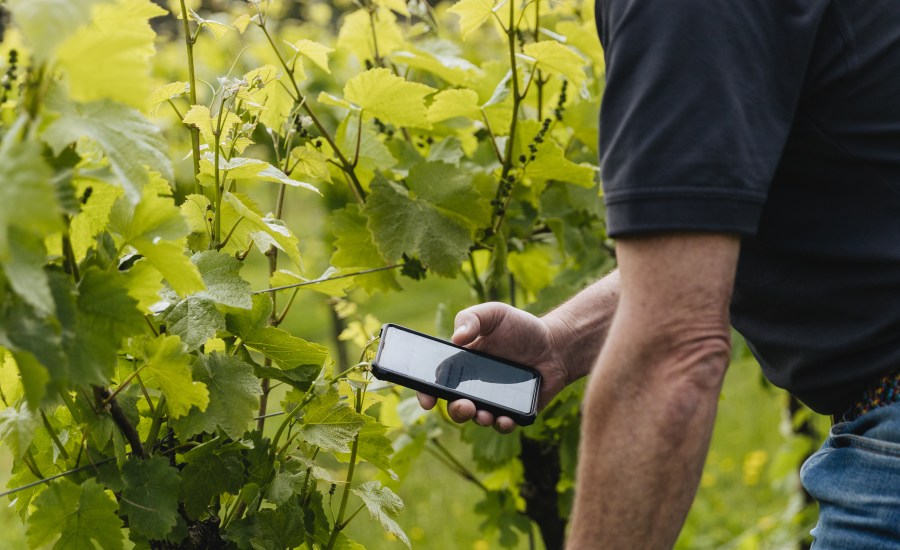Staying ahead of vineyard pests and diseases.
Early detection of pests and diseases is crucial for protecting vine health. By blending tried-and-tested observation with modern technology, problems can be spotted sooner – helping vines thrive.
In viticulture, when it comes to managing pests and diseases, early detection is key. A delay in spotting threats can quickly turn a promising harvest into a compromised one with significant crop loss.
Today’s grape growers face growing challenges: shifting weather patterns, new pest and disease threats, and the push towards more sustainable practices. To stay ahead, vineyards are adopting smarter ways to scout. By blending traditional field observation with new technology, growers are detecting issues sooner and responding faster – helping vines stay healthier and more resilient.
Why early detection matters
Pests like light brown apple moth, spotted winged drosophila and cutworm can wreak havoc on vines if left unchecked. Diseases like powdery mildew, downy mildew, Botrytis, and grapevine trunk diseases (e.g., Eutypa dieback, Esca) can be equally destructive. Some pests act as vectors for disease, therefore early detection matters.
Traditional scouting methods such as visually inspecting vines, are effective but time-consuming and hard to manage in larger or topographically-varied vineyards. That is where smart scouting comes in. Combining human expertise with digital tools helps uncover problems earlier, enabling quicker, more targeted interventions which reduces the reliance on broad-spectrum chemical treatments.
Field observation
Even with the rise of vineyard technology, trained human observation remains invaluable. Skilled workers can spot subtle early signs of trouble – such as leaf discoloration, spotting, curling, powdery growth, lesions, cankers, or dieback – that might not show up clearly on sensors or satellite imagery.
Effective scouting should be systematic and methodical, covering a representative cross-section of the vineyard. Particular attention should be paid to high-risk areas: canopy-dense zones, humid microclimates, and previous outbreak sites. Keeping detailed records of pest and disease incidence, location, severity, and vine health helps build a clear picture of seasonal trends supporting smarter decision-making in how the vineyard is managed.
Digital tools
Technology enhances – rather than replaces – traditional scouting.
- Drones and aerial imaging: Drones equipped with multispectral or thermal cameras can scan large vineyard blocks in minutes and spot early signs of vine stress – from changes in chlorophyll activity to heat signatures – that might indicate emerging pest issues or diseases long before visible symptoms appear.
- Remote sensing and NDVI mapping: Normalised Difference Vegetation Index (NDVI) and similar mapping tools measure plant vigour. Sudden drops in vine health can flag localised problems, such as root-feeding pests or fungal infections like Eutypa dieback, allowing managers to prioritise scouting in those areas.
- Pheromone and smart traps: While traditional pheromone traps are still useful for monitoring pest activity, smart traps (using AI and sensors) can identify and count pest species in real time. This helps manage pests, like moths and fruit flies, more effectively. It can also alert managers to disease risk when pests are known carriers.
- Mobile apps and digital logs: Scouting apps let workers log both pest and disease symptoms from the field, complete with GPS coordinates and images. Some platforms integrate AI that suggest likely culprits based on photos and input. Digital logging improves data consistency and team communication, turning daily observations into actionable insights.
Smarter scouting, better decisions
With real-time data, vineyard managers can make timely, targeted interventions. Whether it’s applying biological controls, scheduling fungicide sprays, or adjusting canopy management, interventions are more effective and sustainable when precisely timed. This can also minimise chemical use, reduce costs and support environmental goals.
Looking ahead
As technology evolves, we can expect even more innovation (eg, disease prediction tools, automated rovers). No matter how sophisticated the tools become, the human role remains critical. The key to success is integrating the insight of experienced vineyard workers with the precision and speed that new technology offers.
By scouting smarter, vineyards aren’t just protecting this year’s harvest – they are building long-term resilience and sustainability for the future.
For more like this, sign up for the FREE Vineyard newsletter here and receive all the latest viticulture news, reviews and insight




